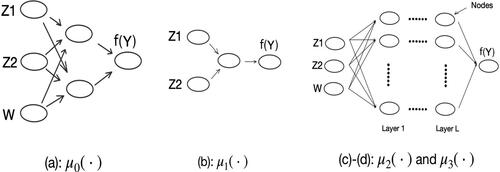Figures & data
Fig. 1 Diagrams of four neural network models: (a) true ; (b) partial
; and (c, d) over-parameterized
and
of (20 nodes in each layer) × L layers, with L = 20 and 100, respectively.

Table 1 Mean square error of each parameter in μ0 (training data n = 300; repetition = 10).
Table 2 Performance of 95% predictive intervals under five different learning models and in two scenarios: coverage rates (before brackets) and average interval lengths (inside brackets) (training data size = 300; testing data size = 20; repetition = 10).
Fig. 2 Plots of predictive curves for (a) and (b)
. In each plot, the red solid curve is the target (oracle) predictive curve
, obtained assuming that the distribution of
is completely known. The two predictive curves obtained using
are in black (solid line for Opt-MSE; dashed line for Neuralnet). The other predictive curves (all in a dashed or broken line and in various colors) are obtained using the other four wrong working models.

